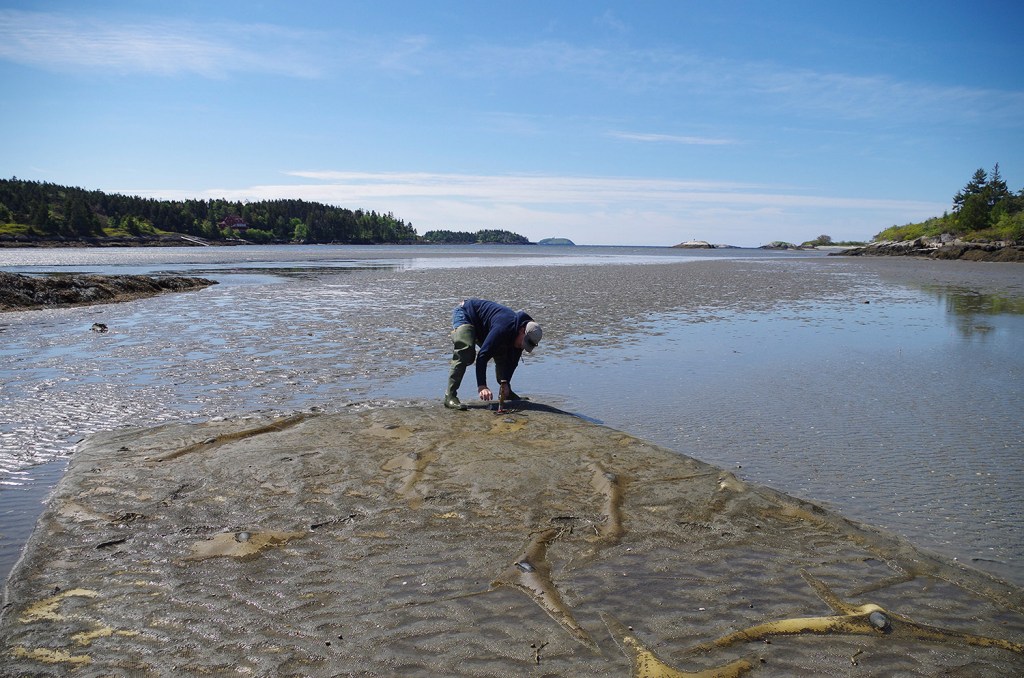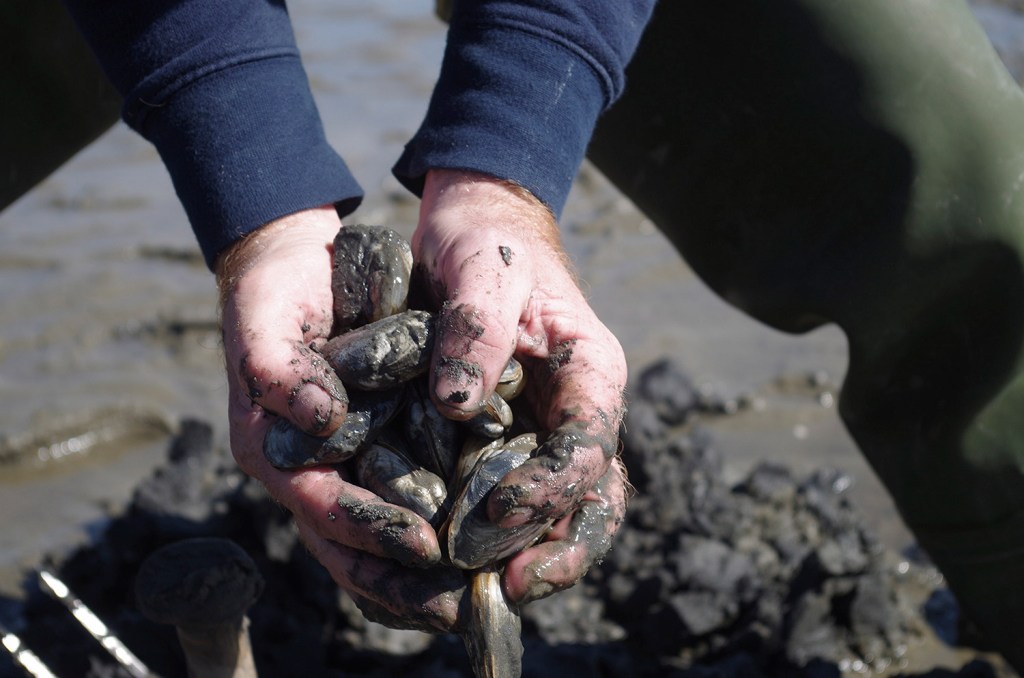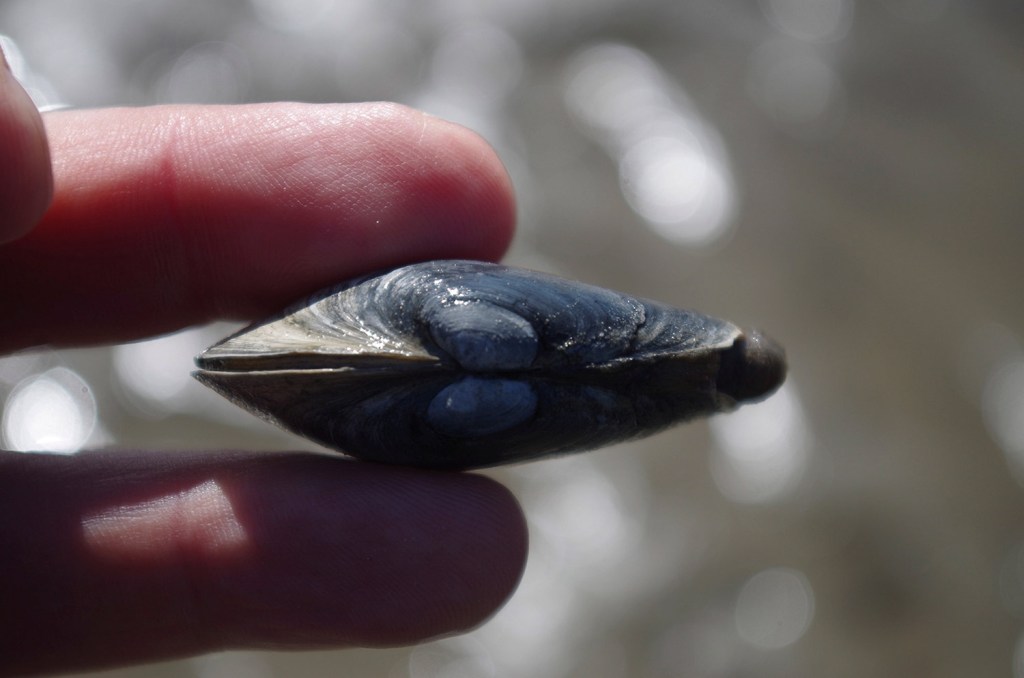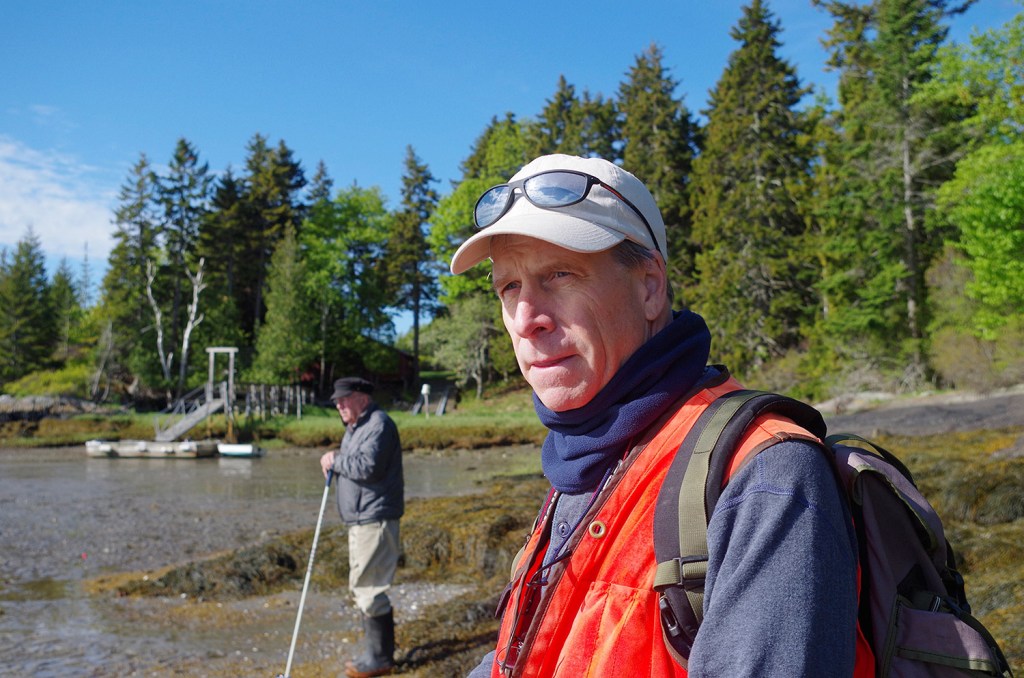GEORGETOWN — Marching across the clam flats near the head of Heal Eddy, you notice two things.
First, both the seafloor and the sea grass meadows on the shoreline are cratered with holes – the work of green crabs, the voracious crustaceans blamed for the widespread destruction of the state’s soft-shell clams.
Then you see Chris Warner’s response: five long rows of what appear to be net-covered garden beds, some 70 patches in all, spread across the exposed ocean bottom at the mouth of a 300-foot-wide cove. Beneath the netting, protected from the hungry crabs, the tiny seed clams Warner planted here in May 2014 have been growing toward harvestable size, grazing on the plankton-rich seawater that floods the area with each tide.
Behold Maine’s first commercial-scale soft-shell clam farm, an experimental project that aims to test whether a single owner-operated farm can earn a worthwhile return for clam diggers who heretofore relied exclusively on the whims of nature to earn a living from the seafloor. If it works, it could revolutionize Maine’s second most valuable fishery, enhance the livelihoods of diggers and stop the assault of the green crabs in their tracks.
But the project has been contentious here in Georgetown, a coastal community 6 miles south of Bath, where some clam diggers fear that self-employed clam diggers like Warner and themselves will eventually be pushed out by corporate growers if the succulent mollusks are farmed rather than gathered in the wild.
“This works – I know it works,” says Warner, a clam digger himself who has been tinkering with farming the succulent mollusks in smaller-scale side projects for nearly two decades and partnered with the Brunswick-based Manomet Center for Conservation Sciences – an environmental science and advocacy group – to scientifically test his model. He predicts an impressive profit when the clams in the plots are harvested in late 2016, especially since he can harvest his clams to order, guaranteeing wholesalers a uniform product.
With an upfront investment of about $10,000, Warner says he expects the 2-acre farm will yield $50,000 in revenue when the clams are harvested, even as he continues to dig for clams elsewhere in the usual fashion. Seed clams will spread into surrounding areas of mud as well, boosting wild harvest, he says, creating a win for everybody.
“This is the future of clamming. It’s not even debatable,” says Chad Coffin, president of the Maine Clammers Association and an enthusiastic backer of the approach. “This is the first step in rebuilding an industry that’s collapsing. It deserves a lot more support than it’s been getting.”
Skeptics maintain faith in nature

Hatchery-born clams like this one betray their ancestry. The white section of the shell dates back to when the then tiny clam was in the hatchery, where the mineral content of the water differed. Colin Woodard/staff writer
Depending on whom you talk to, Maine’s $19 million soft-shell clam fishery is either stable and healthy or in the midst of an apocalyptic crash beneath an army of predatory green crabs, milky ribbon worms, and moon snails, which have thrived as the Gulf of Maine’s waters have warmed in recent years.
Those who think it’s doing fine – including some of Warner’s clam-digging colleagues in Georgetown and the state’s top shellfish manager – say farming projects are unnecessary and would close off parts of what has been a public commons on which diggers hunt, not garden, wild clams. (Maine flats are managed by municipalities, and the research project operates under a temporary scientific study permit from Georgetown.)
“His biggest goal is to create commercial clam farming, and it’s just like the milk farms and everything else – pretty soon you’re selling to a big corporation, and once corporate is involved it’s not good for the entire industry,” Georgetown digger Charles Moore says of Warner and his project. (Warner says he also wants to keep big business out of the picture.)
“The weather goes in cycles, and everything else goes in cycles, and so do clams,” adds Moore, who says he supports getting the scientific results of the project but doesn’t want farms to follow. “If the wind blows right in springtime and the (planktonic clam) seed sets in the flat, then clams are going to be thick in there. If it’s not there this year, it may be on another.”
The head of the state Department of Marine Resources’ shellfish management program, Denis-Marc Nault, is also unconvinced that doomsday is at hand. “It’s hard to say if it’s in crisis or not,” Nault says of the wild harvest clam industry. “Some towns are up, some are stable, and some are down, and in general, landings in the state of Maine have been fairly flat over a 10-year time period.”
The statewide clam harvest has hovered at around 10 million pounds a year since the late 1990s, according to state data, down from a peak of nearly 40 million pounds in the mid-1970s but up from a bust in the late 1950s and early 1960s, when landings fell to 6 million to 8 million pounds.
Nault is also skeptical that the green crab invasion is an existential threat, noting that the clam industry still exists in places like Rhode Island and southeastern Massachusetts, where the water is warmer and presumably even more hospitable for the crabs. The crabs also appear to be less devastating in sandy flats like those in much of Georgetown, he says, though they have wiped out clams across wide swaths of muddy flats off Freeport, Brunswick and Penobscot.
“Shellfish management is all about biomass,” he says. “The more clams you have there when they’re spawning, the higher potential there is for harvesting.”
Predators on the rise

Chris Warner inspects the net protecting one of the plots at his experimental clam farm at Heal Eddy in Georgetown.
Others completely disagree.
Jonesport native Brian Beal, a marine ecologist at the University of Maine at Machias and director of research at the state’s principal clam hatchery, the Downeast Institute on Great Wass Island, has been studying soft-shell clams for three decades. His data paint a stark and consistent picture of a resource driven to the brink by warm water-loving predators, from green crabs to worms.
“Quite frankly, I don’t believe in cycles,” he says. “A lot of this is driven by water temperature. As water temperature increases, we get a higher predation rate because most of the predators are invertebrates who are much more active in warm water.”
Protecting the clams from predation as Warner’s project does is now the name of the game, Beal argues, and he has plenty of data to back it up. Last month in Jonesport and Beals, his students seeded plots with half-inch clams, protecting some with nets and leaving others unguarded. Four days later, 95 percent of the clams in the protected plots were still there, but only 60 percent of those exposed to predators were. “I was just blown away by that,” he says.
In a much larger project last year in Freeport’s Harraseeket River, Beal oversaw the placement of two net-covered plots similar to those at Heal Eddy. Nine months later, 90 percent of the seeded clams had survived in one of the plots, plus a staggering 1,400 wild clams per square foot were taking refuge there, or 330,000 in the 12-by-20-foot plot. Outside the net, just a few feet away, there were just 0.4 clams per square foot.
“That’s pretty … amazing!” he says.
Tending the nets carefully is key, though. The other net over the other test plot on the far side of the river had lifted up from the bottom over the intervening months, allowing milky ribbon worms and green crabs to get underneath. There the number of clams per square foot was the same as the surrounding area and there were hardly any wild clams at all.
Beal, who is helping compile the scientific data at the Heal Eddy test farm, says the farming approach is vital. “We’re giving people like Chris Warner something they can do about the problem as individuals,” he says. “We’re trying to narrow down what works and what doesn’t so we can say: If you want to enhance an area, here’s how you do it.”
Warner says he got involved because he loves digging and feared there would be no clams left for his children’s generation to harvest. “I’m at the clam market” – the wholesale buyer – “almost every day, and I don’t see anybody anymore,” he says. “There aren’t clams anymore, and if this industry goes down, then shame on whomever because it should never go out.”
Who shall farm the mud?

Chris Warner pulls soft-shell clams from the mud of Heal Eddy in Georgetown. If Maine’s first commercial-scale soft-shell clam farm is successful, it could revolutionize the state’s second most valuable fishery. But some self-employed clam diggers fear they will eventually be pushed out by corporate growers.
The project has encountered headwinds from skeptical diggers, surprising its principal scientific investigator, John Hagan of the Manomet Center. “We thought the challenge before us was a technological one: How do you beat the green crabs?” he says. “Turns out the technological problem wasn’t that big – I think we solved it – but then we bumped into a social and cultural challenge we didn’t see coming.”
Local criticism of the project has focused on the fact it occupies mud flats that would otherwise be available for wild harvesters – although it occupies just 2 acres of some 1,200 acres of flats in Georgetown – and the fear that farming will inevitably result in large corporate-owned farms, such as those in Washington state, where diggers like themselves are wage laborers on private oyster and clam farms that own or lease the mud they cultivate. (In Washington, unlike Maine, the intertidal zone is owned by the state, which sold 46,000 acres of it to shellfish farmers in the late 19th century.)
“Georgetown has productive flats and people are making a good living,” says Chad Campbell, chairman of that town’s shellfish committee. “There is a big fear of individuals taking over productive flats and calling it their own for lease purposes.”
But Warner imagines not corporate aquaculture but rather small farms tended to by a single clam digger who can continue to wild harvest at the same time. “The guy who harvests it, he has fire in the belly, he has skin in the game, he works hard and he gets the fruit at the end of the vine,” Warner says. “I like the idea of the one individual.”
It’s a vision of a marine version of Thomas Jefferson’s yeoman republic: independent, self-employed producers earning their living by the sweat of their labor and maintaining the independence so treasured by so many fishermen, clam diggers especially. And Warner says that if diggers don’t embrace it now, creating an individual-oriented model in their towns, the corporate model will find space to move in.
“Farming is going to happen one way or another, and I want big business not to have a chance of coming in,” he says. “When they do, I want our towns to be able to say, no, we’ve already got this set up ourselves; we’re good without you.”
Send questions/comments to the editors.





